 |
HISTORY IN LIQUID FORM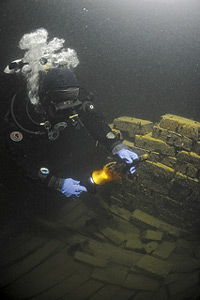
The hauling of the bottles took two weeks of 16-hour diving daysIn July 2010, the world's oldest surviving champagne was discovered in Finnish waters and saw the light of day after a deep slumber of about two centuries at the stern of an unidentified shipwreck. In July 2011, two bottles of the liquid treasure crossed half the globe to their new home – the Russian restaurant Buyan located in Singapore – where they will be displayed as part of the establishment's Wine Museum starting this September.
Every Diver's Dream
The Åland Islands, a group of over 6,000 islands under Finnish administration but with Swedish as the spoken language, and the capital of Mariehamn with a population of about 30,000 people, have been in the international limelight for over a year. All thanks to two divers, Anders Näsman and Christian Ekström, a local fisherman who tipped them off and a tragic event that had taken place in the outer archipelago of Åland in the first half of the 19th century.
There, at a depth of 47 m, the divers found the wreck of a 20-metre-long schooner. Well, "wreck" seems a bad choice of word in this case as the ship manifested no serious damage. Both its masts, intact, were pointing up toward the surface as if the ship had been gingerly put on the seabed by some giant hand. Näsman and Ekström, powerful lamps in their hands to fight the poor near-bottom visibility, started their investigation from the bow. Their first finds were navigation instruments, a kettle in nearly mint condition and some plates. But it was the schooner's stern that housed the real treasure: stacks of unbroken bottles lying embedded in straw.
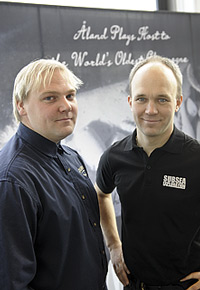
Anders Näsman and Christian Ekström
The divers brought one bottle to the surface hoping to study it for indications that could help date the ship. They opened it and took a swig, anticipating that it would be nothing more than seawater. But boy were they wrong! Inside was perfectly drinkable champagne, complete with the fizz! The constant cold (only 4 to 5 degrees Centigrade) and zero UV light penetration at the dark bottom of the Baltic Sea had created an amazing maritime wine cellar!
The rest of the bottle was taken ashore for local sommelier Ella Grüssner Cromwell-Morgan to evaluate, who found it fizzy and "absolutely fabulous". On 16 July, news of the discovery of the "world's oldest champagne" in Finland was published around the world. The local Åland government imposed restrictions on diving around the shipwreck, and raised the bottles and other items, which were dutifully documented by the Åland Board of Antiquities.
Bubbly Nordic Experience
17 November 2010 has forever marked the history of champagne as the day when the nearly 180-year-old "Baltic" bottles numbering 10 were opened, tasted for assessment and recorked. Richard Juhlin, one of the best champagne experts in the world, was invited by the Åland government to supervise the process. From 1 to 3 December 2010, another 140 salvaged bottles were handled in the same way. According to Juhlin, who personally tasted each and every bottle, one third of them could be classified from "tradable good" to "outstanding". Another third was graded in the middle tier, whereas the remainder was found undrinkable due to seawater penetration.
In June 2011, two of the best bottles – one Juglar, the other Veuve Clicquot – were put up for auction. When my French husband, a wine connoisseur, learnt about it, he recommended that we bid on them. Why? The reasons are manifold.
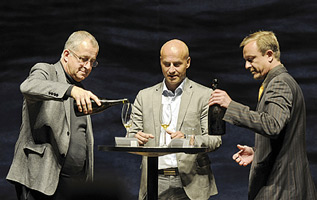
Jean-Hervé Chiquet, owner of Champagne Jacquesson, and Veuve Clicquot's François Hautekeur serving Richard Juhlin the first sip
Firstly, the champagne was assessed as drinkable by the world's leading experts, thus presenting a once-in-a-lifetime opportunity to taste history itself. The salvaged bottles were dated to the 1830s, which means their contents had been produced before phylloxera – insects feeding on vines – had led to the creation of a treatment against them. The treatment had in turn caused additional damage to the vine plants of the Champagne region, so they had to be grafted on to American rootstock. In the case of the Veuve Clicquot bottle auctioned, it was sheer jubilation to know that it had been produced while the Grand Dame of Champagne had been alive (Mme Clicquot died in 1866) and under her personal supervision, as she had always been involved in the production, bottling and shipment of her bubbly.
Secondly, the sunken schooner was believed to be bound for St. Petersburg, meant for Veuve Clicquot's main admirers: Russian aristocrats and the Tsar's family. Thirdly, the ship sank in the waters of the territory, which at the time was technically Russian: from 1809 to 1919, Finland was a Grand Duchy of Finland, a part of the Russian Empire.
All these facts made for an amazing historical link for Buyan, the Russian restaurant in Singapore which, apart from the obvious gustatory experience, strives to offer its patrons a glimpse of Russian history in any imaginable form.
So, to cut a long story short, through anonymous Internet bidding, we, as the owners of Buyan, bid for the two bottles of liquid history, paying €30,000 for a bottle of Veuve Clicquot, and €24,000 for the Juglar, a now-defunct champagne house that used to be one of the favourites of Napoleon I, who had awarded a gold medal to the House of Juglar in 1810. Later, the estate was bought over by Jacquesson, who today produces champagne on the old Juglar lands.
Straight from the Horse's Mouth
After the auction, we couldn't get the bottles to Singapore straight away as proper transportation conditioning had to be found to ensure that the champagnes did not suffer from any loss in quality. There had to be no UV exposure, with the temperature maintained no higher than 4 degrees Centigrade, and no vibration – a recreation of the sea bottom of sorts.
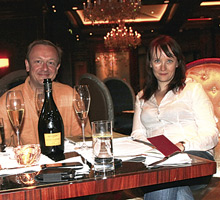
François Hautekeur and Julia Sherstyuk during their first meeting in Hong Kong
Eager to learn more about our treasured purchase, I flew last June to Hong Kong to meet François Hautekeur, Veuve Clicquot's winemaker who, like Juhlin, had been called by the Åland government for the assessment of the salvaged bottles in August, November and December 2010.
We met at the Shangri-la Island bar and ordered a bottle of Veuve Clicquot's La Grande Dame, the House's prestige cuvée, to set the mood for the conversation.
"So, you are one of the few people in the world who have already tasted the contents of the bottles that we bought. How was it?" I asked my first question.
"Absolutely fabulous! The mouth was so complex – I could definitely smell some flowers, sweetness and yet freshness!" Hautekeur replied with a sincere smile. "It was perfectly preserved, partly due to the cold and dark environment, partly to the higher level of sugar content in it. Just imagine – there is only eight grams of sugar per litre in La Grande Dame that we are now drinking, while in the bottle you bought, there is 144 g/l, as we measured it in the sample brought to France. In the Veuve Clicquot archives, which have been kept since the foundation of the house in 1772 till now, the highest sugar content registered was 300 g/l!"
"How was the sugar added and why?"
"In the form of a liqueur or syrup. As to why, the champagne of those times was more like a dessert wine with bubbles. The sweetest taste was that of the Russians, who were Mme Clicquot's most enthusiastic admirers and consumers! Her successful trade with Russia continued till the 1870s."
"Yes, their love is reflected in the works of Pushkin, Gogol, Chekhov."
"And we are very proud that our champagne was even called 'klikofskoye' in Russia at some stage! Even though the first shipment to Moscow took place as early as 1780 and to St. Petersburg in 1781, the true story of the Russian success of Veuve Clicquot champagne started in 1814," continued Hautekeur. "After the Napoleonic wars, maritime routes were cleared of the blockade, and Mme Clicquot used this new opportunity to ship her first batch – more than 10,000 bottles – to the Russian market where it immediately became popular with aristocrats and the royal family." (Later, I read that the price for a bottle of Veuve Clicquot was quite hefty – 12 roubles – for which one could rent a flat in St. Petersburg together with a maid and a cook.)
"How did Veuve Clicquot get involved in the "Baltic" bottles case? Was it the bottles' shape that led to the conclusion?" I asked.
"Not, not at all. In the 18th century, bottles were handmade of blown glass, so they looked more or less the same for all champagne producers. The initial association with us was due to the fire mark on the corks of the first raised bottles, which retained the trace of an anchor, today a widely-recognised logo of Veuve Clicquot, so it was quite logical to jump to the conclusion. But after the corks dried, the initially indiscernible smudge below the anchor took the shape of the word 'Juglar'. It's no secret that the anchor had for long been a symbol of hope in Christianity and, as such, was widely used, even by fellow champagne producers. Our spirits were dampened, of course, but we continued to be involved in the project and soon the divers salvaged 47 bottles of Veuve Clicquot! 19 of them were damaged, but 28 were in outstanding condition!" Hautekeur happily exclaimed.
In the Land of the Grande Dame of Champagne
My next meeting with Hautekeur took place a couple of weeks after, in Reims, capital of the Champagne region in France. 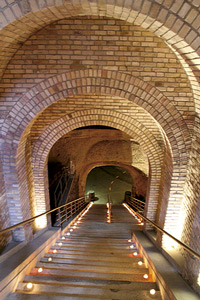
The breathtaking entrance to the cave cellar of the House of Veuve Clicquot
There, I also met Edouard de Nazelle, a descendant of Edouard Werlé, Mme Cliquot's business partner, whose name can be found on the cork of the "Baltic" bottle, in addition to the widow's name. Ambassador of the House, de Nazelle was a well of knowledge and gave us a wonderful tour of the Veuve Clicquot 20-metre deep cellars, which once had been used by Roman soldiers as a food chiller in summer and sleeping quarters in winter.
We also had the pleasure of meeting Veuve Clicquot's cellar master, Dominique Demarville, one of the fortunate few to have tasted the Baltic bottles, who estimated the wine to date to the first third of the 19th century.
When we resurfaced, we were invited by Fabienne Moreau, Veuve Clicquot's in-house historian and researcher, to the House's archives. There, surrounded by hefty volumes of letters, receipts and accounting carefully preserved since its foundation in 1772, I asked her opinion as a historian about the possible final destination of the sunken ship.
"No archive references to the ship's origin or sinking have yet been found, but work is on-going. For me, the most logical hypothesis would be that the champagne was en route to Russia destined for some trading house or even the Tsar's court in St. Petersburg. Another possibility is that it was meant for the Russian officers stationed at Bomarsünd Fortress in Åland, which had been built between 1832 and 1854, the period when Finland was part of the Russian Empire," replied Moreau.
"One Single Quality: The Finest"
All the House's representatives seemed to be genuinely impressed with the personality of Mme Clicquot, born Nicole Barbe Ponsardin. 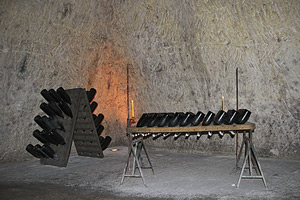
Mme Cliquot invented the riddling table (right), the ancestor of the oblique racks (left), which have been taken up by all champagne houses ever since
They all spoke about her as a visionary, the first woman in the traditionally male-dominated trade whose motto was "One single quality: the finest" with regards to her champagne.
Her position as a widow made her financially independent, allowing her to run a business and hold a bank account. Had she remarried, she would have had to relinquish it all. She was a manageress with a strategic vision. On reading the House's archives, it is clear that Mme Clicquot ran a research laboratory and had a certain number of inventions attributed to her.
For instance, she created the first vintage cuvée in the history of champagne, using grapes exclusively from the 1810 harvest and tying a yellow ribbon to bottlenecks to distinguish these prestigious bottles, which she personally presented to her faithful clients. To this day, no other champagne house has claimed to have had an earlier vintage.
Her other great invention was the riddling technique, which involved inclining bottles over a table after aging to allow for the lees to gather in the bottleneck. When a bottle was opened, the deposits would readily pop out, leaving a clearer and more sparkling wine inside.
Acknowledgment
I would like to express my deepest gratitude to the House of Veuve Clicquot for the warm hospitality shown to my family in Reims over the course of two days: to Stéphane Baschiera, Veuve Clicquot's Chairman, and the abovementioned Edouard de Nazelle, Dominique Demarville, Fabienne Moreau and François Hautekeur. I would also like to thank Adélaïde d'Orléans, Veuve Clicquot's Corporate Communication Manager, for arranging the most interesting tours around Reims and its surroundings for my family.
Text Julia Sherstyuk
Photos Visit Åland, Julia Sherstyuk
|
 +65 6696 7068
+65 6696 7068
 info@meridian103.com
info@meridian103.com
 PDA
PDA
 +65 6696 7068
+65 6696 7068
 info@meridian103.com
info@meridian103.com
 PDA
PDA

Good day, I would like to bring this to the notice of the public about how i met Funding Circle Loan PLC after i lost my job and been denied loan by my bank and other financial institution due to my credit score. I could not pay my children's fees. I was behind on bills about to be thrown out of the house due to my inability to pay my rent, It was during this period my kids were taken from me by foster care. Then i set out to seek for funds online where i lost $3,670 that i borrowed from friends which i was rip off by two companies. Until i was referred to Funding Circle Plc by a very good friend, so if truly you are in need of a loan i advise you contact this Godsent lender via Email: fundingcapitalplc@gmail.com OR Call/Text +14067326622 and be free from scam' Jennie Cortez by name from United State
Jennie Cortez, 2017-11-23